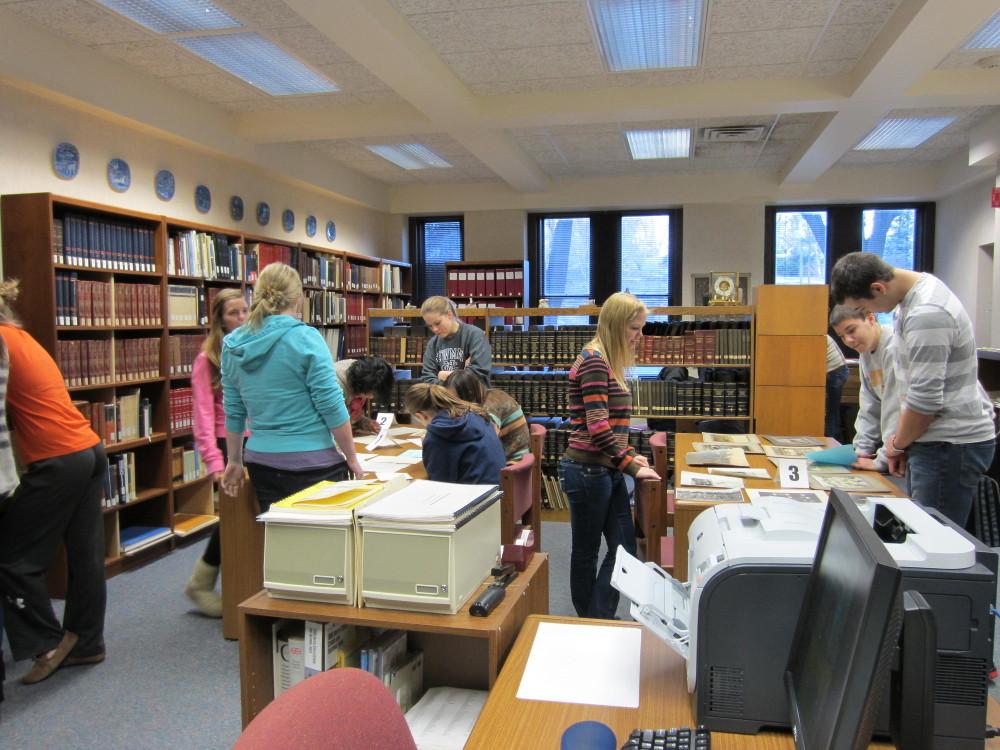50 States of Preservation: The Swenson Swedish Immigration Research Center at Augustana College in Rock Island, Illinois

A display case at the Swenson Swedish Immigration Research Center at Augustana College in Rock Island, Illinois
Image courtesy of the Swenson Swedish Immigration Research Center, Augustana College

A display case at the Swenson Swedish Immigration Research Center at Augustana College in Rock Island, Illinois
Image courtesy of the Swenson Swedish Immigration Research Center, Augustana College
This feature is part of a series we call “50 States of Preservation,” in which we are touring small and mid-sized museums, libraries, historical societies, and other repositories across the country to show how they are helping to preserve the nation’s cultural heritage. Read other entries in the series here.
For most Americans, the story of Swedish immigration to the United States, if familiar at all, has been shaped over the years by Wilhelm Moberg’s classic novel The Emigrants – and the epic 1971 film it inspired starring Liv Ullmann and Max von Sydow – or perhaps even more so by Garrison Keillor’s satirical portrayals in the radio series A Prairie Home Companion. The full account, of course, is much more expansive and nuanced. Preserving and making this history available is the mission of the Swenson Swedish Immigration Research Center, located at Augustana College in Rock Island, Illinois.
The center was founded by Birger and Lyal Swenson on December 31, 1980. Birger Swenson emigrated from Sweden at the age of 17 and graduated from Augustana, one of several colleges established by Swedish immigrants in America. The Swensons were part of a mass migration of some 1.3 million people from Sweden to the United States from roughly 1840 to 1925, an exodus driven largely by economic hardship at home and the prospect of a better life in a new, expanding nation. The largest initial settlements emerged in the Midwest, in states such as Minnesota, Wisconsin, Illinois, and Iowa. This pattern broadened to coastal and urban areas as industrialization became increasingly prevalent in the American economy by the late 1800s. While Swedish newcomers proved more likely to stay in the United States than immigrants from most other parts of the world, nearly one in five ultimately did return home.
The Swenson Center documents these demographic developments and much more, through diaries, letters, photographs, publications, memorabilia, and organizational records produced by Swedish immigrants and their descendants. Included are more than 20,000 books, 800 linear feet of personal papers and records, and large numbers of newspapers and serials, many of them short-lived and scarcely available. The materials chronicle the efforts of Swedish communities throughout North America to sustain their cultural traditions while forging a new identity in a new land.
Although the bulk of Swedish immigration occurred well over a century ago, few archival repositories have devoted their mission to documenting this experience. Among them, the Swenson Center has been a leading force in ensuring that this gap is successfully filled. Highlights of the collection include the records of Upsala College (234 linear feet), established by Swedish immigrants in East Orange, New Jersey in 1893 and closed in 1995. The records underscore the importance placed upon higher education in the Swedish immigrant community – Augustana itself being another example – and the challenges of sustaining such community-based institutions in difficult economic times.
An NEH Preservation Assistance Grant for Smaller Institutions supported a preservation needs assessment of the Swenson Center’s collections by Frances Harrell, a preservation specialist for the Northeast Document Conservation Center. The grant had immediate impact. In addition to the consultant’s assessment, grant funds enabled the center to purchase temperature and humidity readers and dehumidifiers for each floor of the facility. Archivist/librarian Lisa Huntsha reports that this turned out to be “serendipitous timing as the air conditioning in our building went out right after this. Those dehumidifiers were a lifesaver!”
In addressing recommendations made by Harrell, Swenson Center staff produced a disaster plan, along with a five-year preservation plan, and updated its loan practices. The center also created a new budget line for preservation/conservation activities, including book repair, reformatting, purchasing tools, and more. That budget permitted Huntsha to attend a multi-day book repair course at the Campbell Center for Historic Preservation (now known as the International Preservation Studies Center) in November 2015. Huntsha comments that as a result of this training, “it has been incredibly helpful (and has saved us money!) to be able to do in-house book repair and make custom enclosures for some of our higher need materials, undoubtedly extending their life.” With much of the center’s documentation reaching back to the 19th century, the importance of these preservation skills for its small staff is particularly great. Thanks in part to NEH, the Swenson Center will continue to ensure that an important chapter of American immigration history can be effectively studied and understood.
In every state, NEH supports organizations that preserve humanities collections. Preservation Assistance Grants for Smaller Institutions (PAGs) fund projects that help safeguard photographs, letters, documents, prints, moving images, sound recordings, maps, drawings, artworks, textiles, furniture, and artifacts, making them available for future generations. These collections help researchers, educators, and members of the public better understand the complex stories of the various cities, towns, and tribal groups that make up our nation.
Since 2000, NEH has made nearly 2,000 Preservation Assistance Grants to small and mid-sized organizations to preserve and care for their humanities collections. In all 50 states, the District of Columbia, and Puerto Rico and the Virgin Islands, PAG awards have funded preservation assessments, purchase of shelving, environmental monitoring equipment, and preservation supplies, and training for staff. Organizations in all states and U.S. territories are eligible to apply, and the program encourages applications from those new to NEH. The next application deadline Preservation Assistance Grants for Smaller Institutions is May 1, 2018. If you have any questions about this grant program, please contact us at @email or 202-606-8570.










